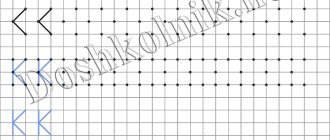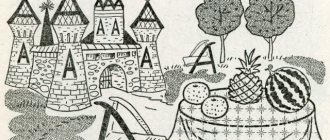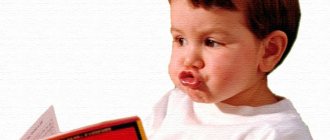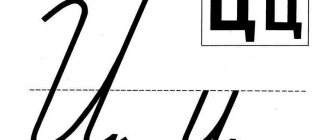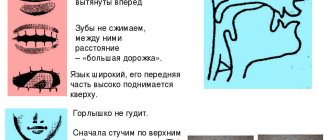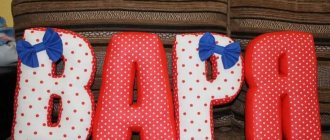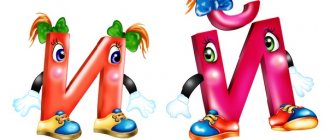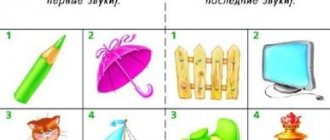LiveInternetLiveInternet
Target: introduce children to the sound and letter “E”.Objectives: to consolidate the skills of distinguishing and correct pronunciation of the sound “e” in syllables, words, phrases; practice determining the place of the sound “e” in words, pronouncing words of a complex syllabic structure; learn to determine the shortest and longest word; improve the skills of sound analysis of words, typing syllables, words, sentences; develop the skill of reading sentences with different intonations; teach children to ask questions to animate and inanimate objects; consolidate the visual image of the letter, develop phonemic hearing, memory, attention.
Equipment: demonstration material - subject pictures with the sound “e”, magnetic board, colored markers, letter “e”, reading tables, ball; handouts - strings, notebooks, pens, colored pencils, cards with the letters “e” and “s”.
Progress of the lesson
I. _ Organizing time.
The one who names the first sound in the word sits down: arch, wasps, smart girl, ears, hoop, etc. .
II.
1.
Repetition of what has been covered:
- clarification of the articulation of the sounds “a”, “u”, “o” and their characteristics.
2.
Getting to know new material. The speech therapist asks a riddle:
No one saw him, but everyone heard him. Without a body - but it lives, Without a tongue - it screams. (Echo)
— What is the first sound we hear in the word “echo”?
The teacher announces the topic of the lesson.
3.
Introducing the articulation of the sound “e”. (When pronouncing the sound “e”, the lips “laugh”).
4.
Choral and individual pronunciation of the sound “e”.
5.
Characteristics of the sound "e". (The sound “e” is a vowel, it can be sung and drawn, and is indicated in red).
6.
Didactic game “Clap, don’t yawn!” The speech therapist pronounces a series of sounds, syllables, words, and the children clap their hands if they hear the sound “e”: e, a, e, u, o, e; eh, ah, uh, eh; Emma, Anna, Edik, echo, Olya.
7.
Game exercise “Speech exercise” (children repeat the chain of syllables):
ep-op-up
whoop-oop-op oop-oop-ep ip-ep-ap ep-ap-ep oop-oop-ep
8.
Didactic ball game “Where is the sound “e” hidden?” (determining the position of the sound “e” in words). Speech material: poet, elf, emblem, whatnot.
9.
Didactic game “What’s missing?” (support - object pictures with the sound “e”: popsicle, excavator, train, screen: . The speech therapist sets
5 subject pictures on a typesetting canvas, children close their eyes, the teacher removes one picture, children open their eyes and answer the question: “What’s missing?”).
10.
Pronouncing words with a complex syllabic structure, dividing words into syllables, determining the shortest and longest words: tightrope walker, electric welder, electric locomotive, electric iron, guide, electrician, crew, electrical appliance, eucalyptus.
11.
Didactic exercise “Who is this? What is this?". Continue the series:
- Who is this? This is a girl, a butterfly, a cat:
- What is this? This is a doll, a chair, a ball:
12.
Physical exercise.
Stand up together and stretch! Walk around, spin around. Hands to the right, hands to the left, and then sit down boldly. Stand up again, stretch and smile at each other.
13.
Introducing the letter “e” (showing the letter). The speech therapist reads a poem:
This is E With an open mouth and a huge tongue.
14.
Laying out the letter “E” from strings, drawing “e” in the air.
15.
Work in notebooks. Printing the letters “E”, “e”; syllables: “em”, “ep”, “et”, “ek”, “me”, “pe”, “te”, “ke”; words: “this”, “emu”, “Emma”.
Copying sentences from the board: “Emma here,” “Emu there.”
16.
Sound analysis of the word: emu (sketching of the sound diagram in notebooks).
17.
Reading sentences using interrogative and narrative intonation:
Who is this? It's a cat. Who is this? This is Emma. Who is this? This is a spider.
III.
Summary of the lesson:
1. - What sound and what letter did we get acquainted with today? Describe the sound "e".
2. - Cross out the letter that is different from the rest (work on cards):
E E E E E S E
3. Assessment of children's activities.
| Oreshkina E.A. |
https://50ds.ru/logoped/10115-frontalnoe-zanyatie-p...e-po-teme-zvuk-e—bukva-e.html
Literacy training “Sound [e] and letter E”
Guess the riddle... Lives without a body, Speaks without a tongue. Nobody sees him, but everyone hears him.
That's right, it's an echo. What is an echo?
An echo is like a reflection in a mirror. Only the image is reflected in the mirror and we see it. And an echo is a reflection of sound, and we hear it. The sound is reflected from any obstacle that comes in its way (from walls, mountains, trees). The echo can be heard in an empty room, in the mountains or in the forest.
For example, in an empty stadium. It is worth shouting something, and having reflected from the concrete steps of the stands, this sound will return many times in the form of an echo. The interesting thing is that the echo will only occur when the stands are empty. If there are a lot of fans sitting on them, there will be no echo, because the sound will not be reflected, because people and their clothes will simply absorb the sound.
The same thing happens in an empty room. As long as there is no furniture or things in it, sound is easily reflected by the walls. But as soon as we put cabinets and chairs there, bring things in, the echo disappears.
Echo often helps a person in many matters. There is such a device - an echo sounder , which is most often installed on ships. It makes sounds underwater, sends them to the sea or ocean, and itself receives the reflected echo. An echo sounder simply measures the depth of the seabed while the vessel is moving. It helps sailors avoid collisions with shoals and reefs.
With the help of radio echo, sailors with special instruments notice treacherous icebergs at a great distance even in the dark, detect enemy submarines in time and sneak up on their ships.
(Based on materials from https://baby-child.ru)
That’s right, the sound [e] is a vowel, it can be sung (the tongue, lips and teeth do not interfere with the free passage of air).
1. Clap your hands if you hear the sound [e] .
Screen, floor, cocoa, tree, skirt, willow, woodpecker, popsicle, eureka, water, brush, this, book, elevator, excursion, electricity, sofa, era, echo, unit, if, children.
2. Find the extra word in the series (by the presence or absence of the sound [e] ):
bus, echo, orange, watermelon; this is an echo, Edik, a mustache.
3. I gra “Who is bigger?”
Think of as many words as possible with the sound [e].
ANSWER: eucalyptus, equator, sketch, etc.
4. Game “Syllable Auction”
Continue the words.
es... (-kiz), esta... (-feta), aero... (-drom), po... (-et), do... (-et).
5. Game “Rhyme”
Think of a rhyme for the word floor.
Answer: hut, jumble, installation, landscape, drainage.
6. Say the word
He rushes over long distances without delay; It is written at the end with two C. It is called... (express)
* * *
To distant villages, cities Who walks on the wires? Serene Majesty, This is... (electricity).
***
On a splinter, in a piece of paper, In a chocolate shirt, It just begs to be picked up. What is this?.. (Eskimo)
* * *
It hooted, it hooted, It hooted and cried, And burst into laughter, And it was called... (echo)
7. Reading G. Yudin’s story “Excavator Operators” (Remember as many words as possible with the sound [e] .)
EXCAVATORS
Yesterday Edik ran up to me from the fifth floor.
- Throw away your labels! - shouts. — We have a real escalator in our yard!
I speak:
— An excavator, probably, escalators are only in the subway.
We ran out into the yard, and there was actually an excavator standing there. The engine is running, but the excavator operator has gone somewhere. We slowly climbed into the cabin. And Edik took it and accidentally touched some hand. The excavator suddenly jerks and starts moving! And ahead is an electric pole. Excavator on this pillar - rrr! Pillar on its side - two! And all the wires broke. In our entire house the electricity immediately went out and electric irons, refrigerators, vacuum cleaners, televisions and everything that was powered by electricity stopped working.
Then the excavator operator came running, shouted and kicked us out of the cab. And in the evening dad came and... Well, I’m not at all interested in remembering this.
- Name the words that you remember with the sound [uh] ...
- What safety rules do you know...
8. Verbal experiment.
— We bought a lot. (popsicle). What can we treat our friend to?... Eskimo.
We ate one thing... (popsicle). We ate a lot of… popsicles. There are many unchangeable words: coffee, coat, Pinocchio.
This is the letter E ...
The letter E opened its mouth: it was either yawning or singing. ( O. Hoffman)
What else does the letter E look like?
The letter E on S marvels,
It's like looking in a mirror.
There is definitely a resemblance
There's just no language. (A. Shibaev)
9. Use a yellow pencil to paint over all areas with the letter E.
10. Game “Magic chain”
1. Turn a floor into a home:
Answer: Floor – heat – watermelon – tooth – side – code – house.
2. Make chains of words in which all words contain the letter “e”.
Elastic – canape – screen.
Electric – canoe – express – figurine – airfield – macrame – era – aloe – crew.
3. Who will turn the echo into a chorus in a few moments?
Answer: echo - ear - ear - hurray - sconce - boa - boron - choir.
11. Game “Find the word”
- Whatnot - floor, river, arch.
- Elastic – eraser, whale, teak, flipper.
12. Game “Complete the word”
Eta (floor), crane (screen), press (express), bale (crew), sport (export), coupon (standard), strada (stage), floor (Hermitage).
13. Game “Puzzle – Echo”
Champion cook buckwheat clamp
Take a closer look at these words and answer the following questions:
- What flower was awarded to the champion?
- What dish did the cook prepare?
- What is the name of the water stream where buckwheat grows?
- Where did you throw the clamp?
Answer: peony, ear, river, pool.
14. Game “Typesetter”
Make words from the letters of the word electric locomotive.
Answer: ditch, cart, gaze, age, lion, call, body, summer, current, etc.
15. We are writing...
16.
Dictionary
- A tow truck is a specially equipped vehicle that is designed for loading, unloading and transporting cars in the event of a breakdown or accident.
- Evacuation is the organized removal of the population, institutions, etc.
- Eucalyptus are evergreen trees, often reaching a height of 100 m.
- Evolution is the development of nature.
- Eureka
- (Greek "I have found") - an exclamation when discovering something new. - An egoist is a person who is overly concerned about his own benefit, gain, and puts his own interests above the interests of other people.
- The equator is an imaginary line that passes through the center of the globe and divides it into two hemispheres: northern and southern.
- An equilibrist is a circus performer who is able to maintain balance on a wire, rope, etc.
- An exam is a test of knowledge, a test in some academic subject.
- An instance is a separate item from many similar items; sample.
- Exoticism - bizarre, unusual features (of nature, customs, art, etc.) of distant countries.
- The crew is the crew of the ship.
- Ecology is the
science of the relationships between organisms and communities among themselves and with the environment. - Economics is
the science that studies how people use their resources for their needs . - An excursion is a visit to a museum, attraction, exhibition, etc.; a trip, a walk for some purpose.
- An expedition is a journey for scientific or military purposes.
- Experiment - experience, research.
- An expert is a specialist.
- Exploitation - use, benefit.
- An exhibit is an item put on display in a museum or exhibition.
- Express - train, bus and other vehicles for traveling long distances with increased speed and fewer stops.
- The elite are the best representatives of society.
- An emblem is a symbol with a specific meaning.
- Emotion is a mental experience, feeling.
- An episode is an incident.
- The standard is an exact measure
- Etiquette is the norms and rules of behavior of people in society.
- Etymology is the science that studies the origin of words.
I recommend reading:
- 77 Effective Educational Techniques
- Mathematics Olympiad (2nd grade)
- Interesting...Great people who changed the world
- Children's competitions and games_8
Tags: Online Russian language reading
Corrective and developmental tasks.Teach the child to identify a word from a series that differs from the rest in syllable structure.
Learn to distinguish between animate and inanimate objects, learn to ask appropriate questions: who is this? What is this?
Teach your child to clearly pronounce the sound [E].
Exercise your child in pronouncing words with a complex syllable structure.
Learn to read sentences, observing narrative and interrogative intonation.
Teach your child to reflect interrogative and narrative intonations in writing using a period and a question mark.
Task 1. An adult pronounces a series of layers, and the child listens carefully and names a word that differs from the others in its syllabic structure:
poppy - bak - so - banana;
catfish - com
- turkey -
house;
lemon - carriage - cat -
bud;
poppy - cancer - broom - tank.
Task 2. Introducing the sound [E]. Guess the riddle, name the first sound in the answer:
Lives without a body
Speaks without tongue.
Nobody sees him
And everyone hears. (Echo)
An adult shows in front of a mirror and explains to the child the articulation of the sound [E]:
- lips in a smile;
- teeth are close together;
- the wide tip of the tongue touches the lower teeth, the back of the tongue is raised;
— the neck “works.”
Sound symbol [E]: the girl reproachfully says to the kitten: “EEE...”
Characteristic
sound [E]: the sound [E] is a vowel, it can be sung (the tongue, lips and teeth do not interfere with the free passage of air). Designation: red circle.
Task 3. Phonetic exercise.
What do fishermen say when a fish gets off the hook? “Uh...h!”
Task 4. Didactic exercise “Clap your hands if you hear the sound [E}”:
uh, ah, uh, y, oh, uh...; eh, ah, uh, eh...; Emma, Anna, Edik, echo, Olya.
Task 5. Repeat after the adult a series of syllables:
pte-kte-bde-where; kte-bde-gde-pte.
Task 6. Find the extra word in the series (by the presence or absence of the sound [E]):
bus, echo,
orange, watermelon;
this is an echo, Edik, a mustache.
Task 7. Remember the names of people starting with the sound [E] (Ella, Edik, Edward, Eleanor, Emma).
Task 8. From a number of drawn objects, choose those whose names contain the sound [E].
Task 9. Speak to the child, syllable by syllable, words that have a complex syllabic structure, explaining to him the meaning of these words. Divide words into syllables. Find the longest and shortest word. If possible, make a sentence with each word:
tightrope walker, squadron, electric welder, electric locomotive, electric iron, guide, electrician, crew, electrical appliance, eucalyptus, elevator.
Task 10. Explain to the child that all animate objects answer the question: who is this?
and inanimate objects - to the question:
what is this?
Learn to ask questions about animate and inanimate objects.
Continue the series:
Who is this? This is a girl, a cat, a dog...
What is this? This is a car, a table, a jacket...
Didactic game “Odd Four” (based on whether objects are animate or inanimate):
car, plane, table, grandfather;
crow, nightingale,
chair,
cow.
Task 11. Introducing the letter E.
The letter E opened its mouth:
Either he yawns or he sings.
O. Hoffman
What else does the letter E look like?
The letter E from fingers: the thumb and index finger of the right hand form a semicircle, and the index finger of the left hand forms the “tongue” of the letter E.
Letter games.
Task 12. Independent sound-syllable analysis of the word Edik:
drawing up a diagram of circles; laying out letters in a cut alphabet, reading, copying.
Reading sentences using interrogative and narrative intonation. Recording sentences under dictation with the help of an adult, reflecting interrogative and narrative intonation in writing (using a period and a question mark).
Who is this? It's a cat. Who is this? This is Edik. Who is this? This is a fly.
Summary of a lesson in an older group of children with severe speech impairments on the topic: Sound E
Sotnikova Valentina Nikolaevna – teacher-speech therapist at the Children's Development Center - Kindergarten No. 33 "Rainbow", Gubkin, Belgorod region.
The lesson notes are recommended for speech therapists in kindergartens. Summary of a lesson in an older group of children with severe speech impairments on the topic: “Sound E” Purpose: to familiarize children with the new vowel sound E. Objectives: 1. Learn to distinguish the sound E from other vowel sounds. Improve the ability to perform sound analysis of EO and AE series. Reinforce the concept of “vowel sound”. 2. Consolidate knowledge on the topic “Vegetables and fruits.” Develop the ability to coordinate nouns with adjectives. 3. Develop phonemic awareness. 4. Cultivate a desire to study. Material: sound E, sound cubes. Notebooks, colored pencils. Cards with stencils of vegetables and fruits. Doll. Progress: 1. Excursion to the city of Sounds. Speech therapist. Let's sing a song of vowel sounds (the speech therapist shows the sounds). Today a new vowel sound E has come to us. - Let's pronounce the sound correctly: smile and open your mouth slightly: E-E-E Speech therapist. What color is the dress of sound E? Children. Red. - The sound E is sung. What is he? Children. Sound E - vowel Speech therapist. The sound E wants to play with you: Game “Raise the plume when you hear the sound E” A I E O U E, house, floor, corner, willow, popsicle, cat, excursion, muffler, donkey, echo Speech therapist. Sound E brought you his favorite pictures. Remember them: popsicle, floor, escalator, eskimo. — What is a popsicle? Children. A popsicle is an ice cream on a stick. 2. Color the popsicle in your notebook. - Tanya, what is your popsicle? Child. Chocolate popsicle. - Vanya, what kind of popsicle is yours? Child. Raspberry popsicle, etc. 3. Sound analysis of a number of EOs using sound cubes: Speech therapist. Let's lay out the EO sound series from the cubes on the track. — What is the first sound in the EO series? Children. First sound E. Speech therapist. Tell us about the sound E. Children. The sound E is a vowel. Speech therapist. Why is the sound E a vowel? Children. Because it is sung. Speech therapist. Place the cube with the sound E on the track. — What is the next sound in the EO series? Children. Next sound O. Speech therapist. Place the cube with the sound O next to the sound E. - Connect the sounds, read the row: E-E - O-O. Speech therapist. Where is the sound E in the series? Children. The sound E is at the beginning of the row. Speech therapist. Where is the O sound in the series? Children. The O sound is at the end of the row. Sound analysis of a number of AEs Speech therapist. Lay out the AE sound series yourself from the cubes. - What is the first sound in the series? Children. First sound A. Speech therapist. Name the second sound in the AE series. Children. Second sound E. Speech therapist. Connect the sounds, read the row: AA-EE. - Name the last sound in the series? Children. Last sound E. Speech therapist. Where is the sound E in the series? Children. The sound E is at the end of the row. 4. Physical education lesson: The escalator goes up - raise your arms up in front of you. The escalator goes down - sit down. One floor, two floors - stand up, raising your arms bent at the elbows in front of you. Buy a popsicle from us - spread your arms to the sides 5. Speech therapist. The Emma doll lives on the second floor of the house. Emma loves to eat vegetables and fruits most of all. Emma drew vegetables and fruits on cards, but did not have time to color them. Let's help Emma. First, color the vegetable by drawing lines from left to right. -What did you color? Children. I colored the cucumber. I colored the tomato. I colored the carrots etc. Speech therapist. What kind of cucumber? Child. The cucumber is oval, green. Speech therapist. What kind of tomato? Child. Tomato is round, red. Speech therapist. Carrots, what kind? Child. Carrots are triangular, orange. Speech therapist. Color the fruit by drawing lines from top to bottom. -What did you color? Children. I colored the apple. I painted the pear. I colored the plum, etc. Speech therapist. What kind of apple? What kind of pear? What kind of plum? — Emma is glad that you colored the vegetables and fruits beautifully. 6. Emma wants to learn with you Marshak’s poem on the sound E: This button and cord, - Electric bell 7. Summary of the lesson. - Give Emma words that start with the sound E.
We recommend watching:
Summary of an individual educational activity with a 5-6-year-old pupil for the correction of sound pronunciation. Notes of an educational activity in a senior speech therapy group. Notes of a lesson in a senior speech therapy group. Notes of an individual correctional and developmental speech therapy lesson. Senior group
Similar articles:
Summary of educational activities in the older group of children with severe speech impairments on the topic: “Sounds S - Z”
Summary of educational activities in the senior group of children with severe speech impairments on the topic: “Sounds S - Sh”
Summary of a subgroup GCD to eliminate disturbances in sound pronunciation in children of the older group with severe speech impairments
Summary of educational activities in the senior speech therapy group on the topic “Cossacks and their traditions”
Logorhythmic lesson for children of senior preschool age with special needs on the topic: “What types of transport are there?”
MAGAZINE Preschooler.RF
Summary of a group lesson in a preparatory school group with FFNR. Class. Sound and letter E. Goals: - correct pronunciation of the sound E in syllables, words and sentences; — acquaintance with the letter “E” — to train children in pronunciation of words with a complex syllabic structure; - develop sound-letter analysis;- teach children to print the letter E; - find the correct image of the letter E among others, construct from elements; — consolidate the ability to analyze a proposal; — clarify and expand the vocabulary. Equipment: - subject pictures, the names of which contain the sound E; — a model of a train with three carriages (with two, three, four windows); kits for drawing up diagrams; proposal outline; ropes of different lengths; sample letter E; “miracle tree” with letters; split alphabet; notebooks; cards with written letters E, pencils.
Progress of the lesson. I. Organizational moment. - The one who names the vowel sounds will sit down. - Remember the words in which the vowel sound is at the beginning of the word.
II. Development of articulatory motor skills. for lips: “Tube”; "Bagel"; "Fence"; “Fence – Tube”; for the tongue: “Scapula”; "Needle"; "Cup";
III. Work on developing breathing and voice. "Peonies". Let's smell the blooming peonies: inhale through the nose - exhale through the nose; inhale through the nose - exhale through the mouth. Voice exercises: sing out the sounds: a-a-a, o-o-o, u-u-u, and-and-and.
IV. Introducing the sound E. 1. Isolating the sound E from words. — A bear came to visit us, her name is Emma. - Say this word. -What is the first sound you hear? 2. Pronouncing the sound E in chorus and individually. 3. Clarification of articulation and characteristics of the sound E (vowel sound, denoted by a red chip)
V. Automation of the sound E in syllables. 1. Repetition of syllables: gde - bde - pte - kte, pte - bde - gde - kte. 2. Sound analysis and synthesis of syllables EK, KE. Game "Live sounds". Children pronounce the syllables one by one, conduct a sound analysis: name the first sound, the second sound; after that, two children choose which sound they will make and stand in the correct sequence, each naming their own sound; the rest of the children check the correctness
VI. Automation of the sound E in words. 1.- Listen to the words and repeat: HEY, THIS, FLOOR, EDIC, ELLA, ELSA. — What is the first sound in each word? 2.–Name the pictures that are displayed on the board: SCREEN, EXCAVATOR, TOUR GUIDE, ESCALATOR, ELECTRICAL APPLIANCES, ECLAIR, ESKIMO, ELECTRIC TRAIN, ELECTRIC LOGO. (The speech therapist helps name unfamiliar words). — What is the first sound in each word? 3.-Dividing words into syllables. Game "Train". The pictures are distributed among the cars in accordance with the number of syllables in the word (after clapping each word) SCREEN, ESKIMO, ELECTRIC TRAIN, EXCAVATOR.
VII. Physical education - Children, now I will give different commands, and you will carry them out, but the “forbidden movement” will be the command “hands down.” (Hands on the waist, up, down, to the shoulders, down, crouched, waved, hands on the head, down, etc.). The most attentive one wins.
VIII. Introducing the letter E. - Let's help the bear Emma prepare for school, introduce her to the new letter E. The speech therapist shows the image of the letter in the picture and reads the verse: “This is E with an open mouth and a huge tongue.”
IX. Writing the letter E with a finger in the air, constructed from strings.
X. Printing the letter E in notebooks using dots.
XI. Find the correct letters E, circle them with a red pencil (the cards are on each child’s desk).
XII. Find the letter E on the “Miracle Tree” (count).
XIII. Sound-letter analysis of the word ECHO. 1. Sound analysis of the word, laying out the diagram. (One child performs at the board, the rest in their places) 2. Compiling a word from the letters of the split alphabet.
XIV. Compose a sentence with the word ECHO according to the proposed scheme.
.
THE CHILDREN HEARD AN ECHO. XV. Summary of the lesson and assessment of children’s activities. — What sounds did you become familiar with? - Give a description of the sound E. - What words did you remember with the sound E.
| Next > |

